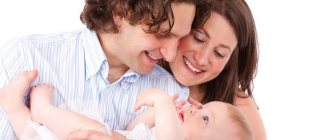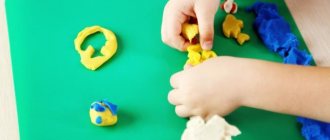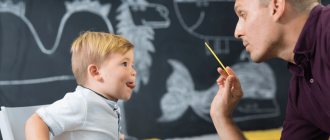Author of popular books on psychological and pedagogical diagnostics of children Strebeleva E.A. Graduated from Moscow State Pedagogical Institute. Lenin. Having received a specialty at the Faculty of Defectology, she worked for many years as a teacher and methodologist at a specialized kindergarten, then taught at the Department of Oligophrenopedagogy at Moscow State Pedagogical Institute.
She made an invaluable contribution to the development of methods for working with mentally retarded children and diagnosing developmental disorders in preschoolers.
In 1999, she was awarded the Presidential Award for her contributions to education. On psychological and pedagogical diagnostics, E. A. Strebeleva wrote more than 50 works, many of which are very popular and are reference books for speech therapists, psychologists and doctors.
Diagnostics by tests
Simple exercises and tests are developed based on many years of research and observations, which made it possible to create the E.A. method. Strebeleva on psychological and pedagogical diagnostics of child development, which has no analogues. It is precisely because of its effectiveness that this method of working with children has received such approval in the reviews of many parents about the results of working on the principles of this methodology.
The exercises include a variety of tests, explanations of how to carry them out, and tables in which the results are recorded for analysis. These tables are subsequently examined. Based on them, a conclusion is made whether the child has developmental disorders. Early diagnosis according to Strebeleva E.A. helps to identify delays in time, conduct examinations, and correct the baby’s condition with the help of treatment and additional activities.
In the book “Orphans” on psychological and pedagogical diagnostics, teachers, defectologists, neurologists, and institutional educators will find a technique that can be used to determine the level of development of children left without parents.
Diagnosis according to Strebeleva E.A. for young children is especially relevant: the smaller the child, the faster you can correct developmental problems, prevent the occurrence of deviations or reduce them. At no other age can developmental problems be corrected so effectively.
This issue was also dealt with by outstanding defectologists L.S. Vygotsky, S.D. Zabramnaya and others.
The influence of adults on children's development
The basis is the position that the child develops in the process of activity, assimilating social experience. In preschool age, these are games; they contribute to the development of motor skills, speech, thinking and perception, and imitation of the actions of adults.
The ability to adopt skills and experience from adults is a criterion for successful development, and can be taken into account when diagnosing Strebeleva E.A. in order to identify mental retardation. That is why the environment in which a child develops is so important, when his personality, relationships to the world, and social behavior are formed.
Speaking about psychotherapy, the author notes that increased conflict and neurotic aggressiveness are often associated with the unfavorable environment in which the child grows up. Group and individual work with parents is important for adjusting the development of children. Psychological and pedagogical diagnostics according to E.A. Strebeleva helps to understand not only the problems in the child’s development, but also what the adults who surround him need to change in their lives. Only an integrated approach will help develop a child to the maximum, taking into account his health and potential.
Diagnostic tasks
Psychological and pedagogical diagnostics Strebeleva E.A. aims to identify deviations, timely prevention and correction. It helps to identify the causes of their occurrence and the severity of violations, make a prognosis, determine an individual work program, and give recommendations to parents on changing the conditions of their upbringing.
This takes into account the biological and social factors of personality development, as well as the fact that their balance differs at each age. That is, what is important is the child’s health, the full functioning of the neuro-anatomical and physiological structures that ensure the functioning of the brain and its development through social interactions, active development during games, learning, imitation of adults, character traits and the nervous system.
At the first stage, interaction with adults is more important for children. And as they grow, the ability to imitate is one of the important criteria that is taken into account when diagnosing according to Strebeleva at an early age. In place of imitation and in its process, opportunities emerge for the implementation of independent ideas in creativity. Therefore, at a very early age, emotional-physical contact is so important for the baby, causing a “revival complex”, which is gradually replaced by objective and verbal communication. But it is impossible to organize every step.
Another important development factor is the spontaneous perception of the surrounding world, events, people that influence his ideas and conclusions, the formation of the psyche. It is important to remember that in preschool age all mental functions develop, the foundation of cognitive abilities, elements of will, self-esteem are laid, stable patterns of personal response to various situations are formed, and a system of values is formed. In the process of formation, they can be corrected, but with age this is much more difficult and often impossible.
Results of the study at the ascertaining stage of the experiment
| Total in group | high level | average level | low level | ||||
| quantity | % | quantity | % | quantity | % | ||
| Experimental group | 24 | 5 | 20,8 | 6 | 25 | 13 | 54,2 |
| Control group | 29 | 4 | 13,8 | 11 | 37,9 | 14 | 48,3 |
As the results of the study show, a high level of sensory ideas about color was identified in 4 preschool children in the control group - 13.8% and in 5 preschool children in the experimental group - 20.8%.
The average level of sensory ideas about color was revealed in 11 preschool children in the control group - 37.9% and 6 preschool children in the experimental group - 25%.
A low level of sensory ideas about color was identified in 14 preschool children in the control group - 48.3% and 13 preschool children in the experimental group - 54.2%.
As we can see, the results showed that most children have a low level of formation of sensory ideas about color.
Related posts:
- Experimental study of the development of coherent speech in preschool children with ODD. Diagnosis of coherent speech in children is carried out using accessible...
- From experience in diagnosing and forming creative imagination Research on creative imagination - diagnosis and its formation in children...
- What is "War and Peace" about? Summary of the novel “War and Peace” by chapters. All answers...
- Features of the formation of sensory standards in young children Formation of sensory standards in preschool children. The tasks of forming sensory…
Diagnostic principles
Diagnosis of young children according to Strebeleva E.A. is based on a number of principles that allow us to obtain an objective assessment of the child’s condition and give the right recommendations for his development.
- The principle of an integrated approach means that the child must be comprehensively examined to determine the characteristics of development and behavior, the state of the emotional sphere, and interest in the cognitive process. That is, developmental diagnostics should be part of a comprehensive examination. If there is reason to believe that disturbances in mental development are manifested, methods of studying the history of the child’s development, monitoring his behavior, games should also be used, and emphasis should also be placed on pathopsychological, neurophysiological research and others.
- The principle of holistic-systemic education involves studying the connections between mental disorders and the causes that cause them, establishing the most important and less significant ones.
- The principle of dynamic study involves considering the child’s condition in the present, as well as in dynamics, taking into account the influence of development when using a special corrective program.
- The principle of qualitative analysis is especially important. All data obtained must be taken into account in the interaction of the child’s mental development and the characteristics of his personality. It notes his personal attitude to the tasks, to the results of the work performed, and the nature of the mistakes. To obtain an objective picture, it is important to combine quantitative and qualitative approaches in diagnosis.
To assess the acceptance of a task, the child’s consent to complete it is taken into account, as well as the child’s interest in the test itself and communication with adults during its completion. Moreover, the child can try to do it on his own, through trial and error, with the help of visual orientation, imitation, or haphazard actions that do not correspond to the properties of objects. If he can act according to instructions, take into account the properties of materials, and balance his efforts taking into account their fragility, we can talk about adequate actions.
When performing a task, you can take into account the child’s learning ability if he performs it by imitation with the help of auxiliary gestures of an adult or verbal advice.
However, here too, in order to obtain an objective assessment, a number of conditions must be met. You can show for repetition how to perform a task no more than three times, and with speech you can evaluate the course of events and indicate goals.
If a child, as a result of learning, moves from inadequate to adequate actions, we can talk about his development, while the lack of ability to complete a task indicates a violation of the emotional-volitional sphere and reduced intelligence. A normal child is interested in results, he gets upset if nothing works out, and rejoices at successes.
In order to draw a correct conclusion about his condition, it is necessary to take into account whether he had opportunities for development, whether the microclimate in the family was appropriate and whether the living conditions were normal. Based on Strebeleva’s early diagnosis, it is possible to create an individual correctional program for the child’s development, give parents advice on upbringing, and make a pedagogical forecast.
Analytical information. Diagnosis of children in different age groups according to the method of E.A. Strebeleva
Analytical information
According to the results of diagnostics of the educational process and child development of young children in group No. 4 “...»
Simferopol for
2020-2021 academic year
In accordance with the annual work plan of the Municipal Budgetary Educational Institution “Secondary School-DS .....” for the 2021/2022 academic year, in order to identify the level of development of interest in cognitive tasks, holistic perception of the subject image, ensuring a person-oriented approach in correctional and educational work with children in At the preschool institution, from September 14 to September 25, 2022, a psychological and pedagogical diagnosis of children was carried out using the method of E. A. Strebeleva “Psychological and pedagogical diagnostics of the development of young children.”
-Teacher: Vlasenko M.V.
-Children's age: 4-6 years.
-Royal composition: 16 children.
-There are 15 boys.
-Girls 1.
The technique allows you to evaluate the following psychological parameters: 1. Acceptance of the task.
2. The adequacy of its solution.
3. Learning ability during diagnostic examination .
4. Attitude to the result of one’s activities.
In mixed-age group No. 4, 16 children were diagnosed at the beginning of the year, which is 100%.
The first subgroup (age 4-5 years) diagnosed 3 people and amounted to 18%. The second subgroup (age 5-6 years) diagnosed 9 people and amounted to 57%. The third subgroup (age 6-7 years) diagnosed 4 people and amounted to 25%.
Initial diagnostics of cognitive development of children aged 4-5 years (3 people) according to the method of E. A. Strebeleva showed the following results:
Group 1 -1 person - 30% Group 2 - 0 person - 0% Group 3 -2 people - 70% Group 4 - 0 person - 0%
The initial diagnostics of the cognitive development of children aged 5-6 years (9 people) according to the method of E. A. Strebeleva showed the following results:
Group 1 -0 people - 0% Group 2 - 1 person - 11% Group 3 - 6 people - 67% Group 4 - 2 people - 22%
Initial diagnostics of the cognitive development of children aged 6-7 years (4 people) according to the method of E. A. Strebeleva showed the following results:
Group 1 - 0 people - 0% Group 2 - 0 people - 0% Group 3 - 2 people - 50% Group 4 - 2 people - 50%
Based on the results of diagnostics using the method of E. A. Strebeleva, general indicators were obtained for a group of children aged 4-7 years:
Group 1 - 1 person - 6% Group 2 - 1 person - 6% Group 3 - 10 people - 63% Group 4 - 4 people — 25%
The first group consists of children who are not guided in their actions by instructions, do not understand the purpose of the task, and therefore do not strive to complete it. They are not ready to cooperate with adults. Without understanding the purpose of the task, they act inappropriately. Moreover, this group of children is not ready to act adequately even under conditions of imitation.
The indicators of children in this group indicate deep disadvantage in their intellectual development.
The second group consists of children who cannot complete the task on their own. They have difficulty coming into contact with adults and act without taking into account the properties of objects. The nature of their actions is marked by the desire to achieve a certain desired result, therefore they are characterized by chaotic actions, and in the future - refusal to complete the task. In a learning environment, when an adult asks them to complete an imitation task, many of them do it. However, after training, the children of this group cannot complete the task independently, which indicates that the principle of action remained not realized by them. At the same time, they are indifferent to the results of their activities.
The third group consists of children who cooperate with adults with interest. They immediately accept tasks, understand the conditions of these tasks and strive to complete them. However, in many cases they cannot find an adequate way to do it on their own and often turn to an adult for help. After the teacher shows how to complete the task, many of them can independently cope with the task , showing great interest in the result of their activities.
The fourth group consists of children who accept all tasks with interest and complete them independently, acting at the level of practical orientation. At the same time, they are very interested in the results of their activities. These children, as a rule, achieve a good level of mental development.
Conclusions. Having analyzed the results of cognitive diagnostics of young children of group No. “”, we can conclude that analysis of diagnostic results at the beginning of the school year shows stable dynamics of children’s development in all types of activities. Basically, the indicators of implementation of the educational program of preschool education are within the average level.
Recommendations.
(What is planned to be done during the year)
1. Continue to carry out targeted work to improve the quality of mastering program material in all educational areas.
2. Throughout the year , continue to develop children’s speech and communication skills in direct educational activities and in individual work with children based on an integrated approach.
3.Continue to work on sensory development in different types of activities.
4. Continue to develop and expand vocabulary, teach communication with teachers and peers.
5. Develop children's gaming skills. Strengthen the ability to negotiate in games with peers.
6. Continue to develop independence. Responsibility, hard work.
Assessment of task completion
If, after completing the tasks, the child scores 34-40 points, it is considered that he has no deviations.
Four points are given for a test that the child immediately begins to perform independently or in collaboration with adults.
A child receives three points if he has contact with an adult, completes a task only after training, and acts adequately.
Two points are given when a child strives to achieve a goal, acts adequately, but cannot cope independently even after training.
The child receives one point for inappropriate actions or failure to understand the purpose of the task.
Diagnosis of mental development of young children
DIAGNOSTICS OF MENTAL DEVELOPMENT OF EARLY CHILDREN
(E.A. Strebeleva)
The technique was developed for diagnosing children 2-2.5 and 2.5-3 years old. For children of the second subgroup, in some tasks the stimulus material becomes more complex and its volume increases. To process the results, qualitative and quantitative analysis is used. The diagnostic procedure includes a training stage.
Qualitative indicators - ways of completing tasks:
1) acts inadequately;
2) understands the goal, but acts independently without taking into account the properties and qualities of objects, that is, chaotically; acts adequately under training conditions, but does not perform independently even after training:
- independently completes the task after training;
- immediately completes the task independently.
Task 1. Catch the ball!
Objectives of the study: establishing contact with an adult, assessing understanding of verbal instructions, and the ability to follow a moving object with the gaze.
Equipment: groove, ball.
Procedure. The teacher places the ball on the groove and asks the child: “Catch the ball!” Then he turns the groove towards the child and asks him to roll the ball along the groove: “Roll!” An adult catches a ball. The game is repeated 4 times.
Education. If the child does not catch the ball, the adult shows him several times (up to 2) how to do it.
Action evaluation. Acceptance of the task, desire to play with an adult, attitude towards the game, towards the result.
Task 2. Hide the balls!
Objectives of the study: identifying practical orientation to magnitude, the presence of correlating actions.
Equipment: 2 rectangular boxes of the same color with lids of the same color and shape, but different in size, 2 balls (for the second subgroup - 3 boxes and balls).
Procedure. There are 2 boxes in front of the child and their lids at some distance. The teacher puts a large ball in a large box, and a small one in a small one and asks the child to hide the balls, that is, to cover the boxes with lids. It does not explain which cover to take.
Education. If the child selects the lids incorrectly, the adult shows and explains: “We cover the large box with a large lid, and a small one with a small lid.” Thus, in the diagnostic process, the teacher shows the method of action and fixes in a word the property of objects (quantity) that the child should focus on. After training, you are asked to complete the task yourself.
Action evaluation. Acceptance of a task, methods of execution, learning ability, presence of correlating actions, attitude to the result.
Features of development up to 3 years
The life of a baby is full of adventures and amazing discoveries. As soon as he begins to walk, his dependence on an adult decreases, he begins to zealously explore the surrounding space and study objects. Every day he acquires more and more skills with the help of which he learns to use things, and already in the third year of life his leading hand and the coordination of actions of both hands are determined. Seeing a new object, he wonders what can be done with it. By playing with different toys, he learns colors, shapes, weights, and develops tactile sensations.
If he is offered a choice based on a sample, then first he takes into account the shape, size, and then color. In the second or third year of life, speech develops intensively in the process of communication and special activities. At an early age, a child intensively learns to communicate and show emotions, speak, perceive information, draw conclusions, and move.
Diagnosis of early and preschool children with intellectual disabilities
Completed by: student of group 4 BPO-DSHI Glushkova Tatyana Olegovna
| Age | Diagnostic directions | Diagnostic tools | Requirements for diagnostics |
| Early age | 1.Understanding verbal instructions. 2. Orientation of the child to size. 3.Visual perception. 4.Holistic perception. | METHODS STREBELEVA E.A. The presented methods (10 tasks) make it possible to study the possibilities of manifestations of a child’s mental development in its various aspects. Since many of the young children examined do not speak speech or speak it insufficiently, most of the proposed tasks are non-verbal, and the results of their implementation are assessed based on the child’s actions. The tasks are offered taking into account a gradual increase in the level of difficulty, from the simplest to the more complex. Catch the ball! The task is aimed at establishing contact between a child and an adult, assessing his understanding of verbal instructions and his ability to follow a moving object with his gaze. Hide the balls! The task is aimed at identifying the child’s practical orientation to magnitude, as well as the presence of correlating actions. Parsing and folding a matryoshka (two-part) task is aimed at identifying the level of development of the child’s orientation to the size of objects, as well as identifying the presence of correlative actions in him. Parsing and folding a pyramid task is aimed at identifying the child’s level of development of practical orientation to the size, presence and nature of correlating actions, determining the leading hand, and the coordination of actions of both hands. The paired pictures task is aimed at identifying the child’s level of development of gaze fixation, visual perception of object pictures, and the presence of a pointing gesture. Colored cubes (color perception) task is aimed at identifying the formation of visual perception of color. Cutting pictures task is aimed at identifying the level of development of a holistic perception of an object picture. of constructing from sticks (triangle, hammer) is aimed at identifying the level of development of holistic perception, analyzing a sample, and the child’s ability to act by imitation, by showing. | • before starting the examination, we establish stable positive contact with the child; • during the examination, we support the child’s interest in the tasks being performed; • we strictly dose out various types of assistance to the child and make sure to record them in the examination report; • each type of task begins with an easy (training) version, so that the child understands what the task is and feels satisfaction from its successful completion; • we offer the child multifunctional tasks that provide assessment on several indicators of cognitive development at once; • the duration of testing does not exceed 20 minutes, at the first signs of fatigue, switch to another type of work; • I individualize the sequence of presented tasks (easy/difficult, verbal/non-verbal, educational/game), alternating tasks taking into account the leading analyzer (visual, auditory, tactile, kinesthetic); • when presenting multi-unit instructions, we use speech structures that are simple in grammatical design, and provide for repeated step-by-step presentation of the task (I divide the instructions into separate semantic units). |
| Preschool age | 1. Sensory development. 2. Mental development (learning in the process, acceptance of a task, methods of completing tasks). 3. Cognitive sphere (can one independently find and use auxiliary objects to achieve a goal) 4. Emotional-volitional sphere (rules of behavior, assessment of one’s results, etc.) | To identify the level of development of visual perception, a number of methods are used: - Inclusion in a series (methodology of A.A. Wenger). — Box of forms. — Group the pictures (by color and shape). — Fold the cut picture. A valuable feature of these methods is that all tasks provide for the possibility of providing children with strictly dosed assistance; parameters for assessing the child’s actions are proposed; results are assessed in points. Stability of attention and switching capabilities are studied using the “Simple Coding” method by Pieron-Ruzer and the “Corrective Test” by E. Landolt. According to the latest technique, you can express the level of concentration using an accuracy index. K=S*S/n Where S is the number of rows of the table worked by the child; n – number of errors (omissions or erroneous strikeouts, extra characters). To study the characteristics of memory, the following methods were chosen: A.R. Luria to determine the state of short-term memory, Jacobson to identify the ability to remember, M.S. Bernstein “Figure Recognition”, aimed at testing the level of memory development, A.N. Leontiev “Indirect memorization”, with the help of which it is established whether the child has logical methods of memorization. -Methodology “Construction of objects” The children were asked to assemble a picture from four parts, cut horizontally and vertically from four parts, cut diagonally. — Matryoshka dolls (4-part), (understanding of the instructions and purpose of the task, use of help, reasonableness of actions, taking into account the size of the doll are revealed); - Seguin boards (allows you to identify coordination, dexterity of movements, the state of fine motor skills of the fingers); -cubes of different sizes (the formation of the concept of the size of objects is studied); — Lotto (allows you to trace the nature of mental operations); — Grouping of objects (modified method of U.V. Ulienkova) — identifying abilities to classify objects; - Match the figure to the object (modified version of L.A. Wenger’s technique) - study of the level of formation of perceptual actions; identifying the ability to correlate an object with a standard, the level of knowledge about forms; identifying the ability to transfer learned perceptual action to new conditions. - Exclusion of objects that do not fit into the group (modified version) - explore the ability to see their essential features in objects, and make the necessary generalizations on this basis; identify the ability to establish similarities and differences between visually perceived images. — Grouping of toys (adapted version of L. A. Wenger’s technique); — Fold a cut picture (of three parts); — Get the cart (with a rod; adapted version of S. L. Novoselova’s technique); — Mosaic (the presence of interest, volitional efforts, spatial orientation, the ability to transfer the shown method of action, imagination, fine motor skills are examined); -Methodology: “What’s gone?” (modified method of S.D. Zabramnaya); -Methodology: “What has changed” (modified method of S.D. Zabramnaya); | • before starting the examination, we establish stable positive contact with the child; • during the examination, we support the child’s interest in the tasks being performed; • we strictly dose out various types of assistance to the child and make sure to record them in the examination report; • each type of task begins with an easy (training) version, so that the child understands what the task is and feels satisfaction from its successful completion; • we offer the child multifunctional tasks that provide assessment on several indicators of cognitive development at once; • the duration of testing does not exceed 20 minutes, at the first signs of fatigue, switch to another type of work; • I individualize the sequence of presented tasks (easy/difficult, verbal/non-verbal, educational/game), alternating tasks taking into account the leading analyzer (visual, auditory, tactile, kinesthetic); • when presenting multi-unit instructions, we use speech structures that are simple in grammatical design, and provide for repeated step-by-step presentation of the task (I divide the instructions into separate semantic units). |
How does the lag manifest itself?
If a child has problems and developmental delays, this manifests itself in movements and games. The actions of such a child are often unfocused, and there is no interest in toys. Instead of wondering what it is and what it is for, he may pick up the toy and throw it without exploring. Gait and movements are often uncoordinated. There is also a lack of interest in the results, which can manifest itself in drawing lessons and games.
Sometimes there is poor development of neatness and independence skills, articulation and sound discrimination work poorly. Such children begin to talk only at the age of three, often due to the fact that there is no interest in the world around them, there is no sufficient emotionality, which is noticeable even in the face.
Diagnostics of cognitive development for a 3-4 year old child using the method of Strebeleva E.A.
Map of the cognitive development of a 3-4 year old child.
1. Last name, first name, patronymic of the child
2. Date of birth _________________ date of admission to the group
3. Information about parents _______________________________________________________________________________________________________________________________________________________________________________________________________________
4. History data
________________________________________________________________________________________________________________________________________________________________________________________________________________________________________________________________________
5. Conclusion of the PMPC
6. Collaboration with adults
| September | January | May |
| Easy to contact | ||
| Is he proactive or passive when communicating? | ||
| Communication is unstable | ||
| Selective communication | ||
| Selective negativism |
I
Cognitive development
1. Identifying the level of play.
| "Play" | September | January | May | |||
| Showing interest in toys | ||||||
| Interest in one toy | ||||||
| Nature of actions with them: Adequate/inadequate | ||||||
| Specific/non-specific manipulation | ||||||
| Subject-game actions | ||||||
| Story game | ||||||
| Imitation actions. | ||||||
2. Identification of the level of development of practical orientation towards form (the ability to use the trial method when performing practical tasks).
| "Box of Forms" | September | January | May |
| Acceptance and understanding of the task. | |||
| How to do it: - chaotic actions; targeted samples | |||
| Learning ability | |||
| Attitude to the result of one’s activities |
3. Identification of the level of development of orientation towards magnitude.
| “Take apart and put together a matryoshka doll” (4-part) | September | January | May |
| Acceptance and understanding of the task. | |||
| How to do it: - chaotic actions; targeted samples | |||
| Learning ability | |||
| Attitude to the result of one’s activities |
4. Identification of the level of development of holistic perception of the subject image in the picture.
| “Fold the picture” (in three parts) | September | January | May |
| Acceptance and understanding of the task. | |||
| How to do it: - chaotic actions; targeted samples | |||
| Learning ability | |||
| Attitude to the result of one’s activities |
5. Identifying the ability to analyze and compare images, find similarities and differences.
| "Find a Pair" | September | January | May |
| Acceptance and understanding of the task. | |||
| Ability to analyze and compare images in a picture. | |||
| Learning ability | |||
| Attitude to the result of one’s activities |
6. Identification of the level of development of object drawing.
| "Draw" | September | January | May |
| Acceptance and understanding of the task. | |||
| Level of formation of interest in drawing | |||
| Formation of prerequisites for drawing: ability to hold a pencil | |||
| Availability of subject drawing | |||
| Attitude to the result of one’s activities |
7. Identification of understanding of the plot image, the level of development of coherent speech.
| "Story pictures" | September | January | May |
| Acceptance and understanding of the task. | |||
| Level of development of coherent speech: - lack of active speech; - the presence or absence of phrasal speech, understandable or obscure to others; - speech consisting of individual words or reflected. |
Conclusion__________________________________________________________________________________________________________________________________________________________________________________________________________________________________________________________________________________________________________________________________________________________________________________________________
Evaluation using tables
It was to identify the real picture that a system of exercises was developed for diagnosing early development according to Strebeleva E.A. in children aged 2-3 years. This system requires filling out a table that has columns for 2-2.5 and 2.5-3 years. It also offers various simple tasks. For example, assemble and disassemble a nesting doll from 2-3 dolls, put together a pyramid of three rings, put together puzzles from 2-3 pieces, select cubes by color. Some classes are duplicated by type to eliminate the influence of subjective factors
It is suggested to find paired pictures, draw a path or a house. The child may doodle, scribble something with a purpose, draw lines to resemble a picture, or complete a task.
Each assignment has instructions to help you grade it. For example, a child can disassemble and fold a nesting doll, do it by imitating an adult, try to do it on his own, but cannot compare the sizes, pull the matryoshka into his mouth or use it for knocking and throwing. This is considered a relative norm.
Reviews from many parents convince us that using E.A.’s method. Strebel diagnostics of child development will help to timely detect deficiencies in the formation of specific skills, evaluate them, give them characteristics, and then select or create the right programs for correcting the condition, and give recommendations for contacting specialists. The tasks are given according to the principle from simple to complex, so they must be carried out exactly in the order in which they are indicated in the tables.
Those who scored 10-12 points based on the results of completing tasks belong to the first group, 13-23 - to the second, 23-33 - to the third, 34-40 - to the fourth.
Recommendations for development based on testing results
Children of the first and second groups are recommended to increase physical activity, including a variety of movements for general development, strengthening the back muscles, coordination and balance. They need more activities with adults, emotional communication and contact. They also need to learn to work according to a model and verbal instructions, do more exercises and games that develop motor skills, the leading hand, coordination of movements, and speech stimulation.
Other tables and tasks for early diagnosis Strebeleva E.A. are offered for children aged 3 to 5 years. At this time, the child receives a new impetus in development, is literally overloaded with information, knowledge, and the desire to share it with the outside world, but still experiences certain difficulties associated with restrictions from parents, insufficiently developed movements and speech. Preschoolers aged three to five gradually master the ability to think, compare events, actions, and think about actions in their minds, and not just in a visual, objective manner.
It is at this age that the child is less interested in objects and the actions associated with them than in objects and the human relationships associated with them. Corresponding games appear that require several participants.
This is the time for the development of visual-figurative thinking, memory, and the formation of social attitudes. The child may act not according to a model, but according to verbal instructions; speech becomes from accompanying an event to planning.
For diagnosis according to Strebeleva E.A. Corresponding tables are offered for children 3-4 years old, 4-5 years old, many tests are similar to those discussed above, but are offered in a more complex version. Their implementation will help to give the right advice on the child’s development and take timely measures to correct it.
The use of tests allows you not to miss invaluable time, when even children who are lagging behind in development for various reasons can be brought up to speed with the help of exercises and the creation of a warm atmosphere of trust, and there are no other such periods in a person’s life. Diagnostics Strebeleva E.A. evokes positive feedback from educators, doctors, teachers.
Purpose of the technique
Diagnostics is aimed at determining the level of development:
- Subject-game actions
- Perception of shape, size, color
- Holistic perception of the subject image
- Visually effective and visually imaginative thinking
- Object drawing, understanding of the plot image
- Connected speech
- Formation of quantitative ideas
- Ability to analyze and compare images, find similarities and differences
- Ability to act purposefully, guided by a model
The technique is recommended for specialists in psychological, medical and pedagogical consultations (PMPC), psychologists and defectologists of preschool educational institutions.









